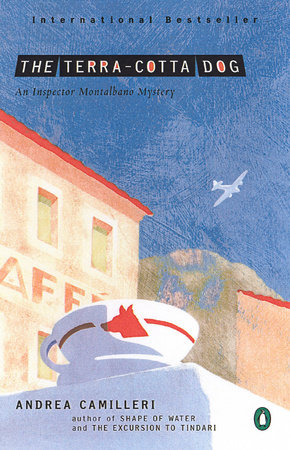READERS GUIDE
Questions and Topics for Discussion
INTRODUCTION TO THE TERRA-COTTA DOG
From the very first pages of The Terra-Cotta Dog, the second Inspector Montalbano mystery from the pen of Andrea Camilleri, the detective’s world seems to have been turned upside down. First comes a secret face-to-face meeting with a dreaded Mafioso who wants nothing more than to have himself arrested. Then there is the matter of the unknown thieves who clean out Carmelo Ingrassia’s supermarket, only to leave all the stolen merchandise in a tractor trailer behind a nearby filling station. Just as life is starting to make sense again, an eighty-year-old Fascist who prides himself on his slow driving dies behind the wheel in a high-speed crash, only hours before a scheduled meeting with the inspector. Strange as the inspector’s own times may seem, however, the most intriguing and poignant mystery is yet to unfold, and it comes not from the present, but from the past. While retrieving a cache of smuggled weapons, the inspector happens upon a pair of desicated corpses in a long-forgotten cave, entwined in a lovers’ embrace beneath the unblinking eyes of a terra-cotta dog.
As other events lead him toward mortal danger, Montalbano finds himself obsessively drawn to unearth the story of the two dead lovers. Not only must he learn what happened to them, but he must also confront the reasons why he finds their secret so absorbing. Is his interest, as the police commissioner suggests, merely a form of “mental masturbation”? Does he see some fleeting image of his own identity in the mysterious remains? Or is it that, in a world of corruption, violence, and deceit, he hopes to find some tattered remnant of purity and decency in the voiceless past? In this masterly novel, in which all explanations seem possible yet so much seems inexorably fated, Inspector Montalbano is less concerned with determining whodunit than with seeking rest for departed spirits and finding solace for his own.
ABOUT ANDREA CAMILLERIAndrea Camilleri’s Montalbano mystery series, bestsellers in Italy and Germany, has been adapted for Italian television and translated into German, French, Spanish, Portuguese, Greek, Japanese, Dutch, and Swedish. He lives in Rome.
DISCUSSION QUESTIONS FOR THE TERRA-COTTA DOGInspector Montalbano’s passion for food is a touchstone of his character. What, in your view, do the frequent descriptions of food contribute to this and, if you have read them, other Inspector Montalbano mysteries? Is it significant that Montalbano is so often shown eating, but so seldom preparing his own food?
Montalbano often uses questionable methods to achieve his goals, as when he uses blackmail photographs to intimidate Ingrid’s father-in-law. Do Montalbano’s ends always justify the means, or do you sometimes find his conduct unacceptable?
Alcide Maraventano suggests to Montalbano that life involves a vast system of diverse codes that people are always devising and deciphering. One such code is represented by the unlikely objects found near the mummified corpses of Lisetta and Mario. What kinds of messages can visual codes communicate that written words cannot? In what ways is The Terra-Cotta Dog a coded text?
In The Terra-Cotta Dog, Montalbano continues his vexed relationship with the press. Early in the novel, he barely makes it through his appearance at a press conference. Later in the book, however, he makes adroit use of the news media to prompt a key figure in the mystery to come forward. What has Montalbano learned about the manipulation of the media?
Typically, detective fiction starts with a crime and moves linearly toward the apprehension of the perpetrator. Andrea Camilleri’s mysteries do not consistently follow this pattern. Rather, Camilleri uses the subgenre of the “police procedural” to engage thoughtfully in character development and to raise issues of moral ambiguity. How does Camilleri manage to resist some of the usual expectations of detective fiction while telling an engaging story?
In probing the mysteries of the Crasticeddru cave, Montalbano fears that he has desecrated both life and death. To feel that one has desecrated something, one must have a sense of the sacred. What, in the eyes of Inspector Montalbano, is sacred?
In The Terra-Cotta Dog, Montalbano is almost as frustrated by his law enforcement colleagues as he is bedeviled by the forces of the Sicilian underworld. How do the personality quirks and periodic incompetencies of the inspector’s fellow officers contribute to the atmosphere of Camilleri’s work?
Although Montalbano has rewarding friendships with women he respects intellectually, he routinely exasperates the women in his life who approach him with romantic intentions. How can it be that he is so comfortable with women on one level, but so ill at ease with them on another?
In the violent, corrupt milieu that is Vigàta, opportunities for redemption are scarce. If the possibility of redemption exists in The Terra-Cotta Dog, what are its sources? Despite its violence, is The Terra-Cotta Dog an essentially optimistic novel?

